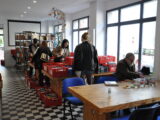Flohmarkt für Gedrucktes. Wie immer mit vielen alten und nicht so alten Büchern aus allen Bereichen: Klassik und Science Fiction, sex & crime, Kunst, Design und Architektur, mit Garten-, Koch- und Kinderbüchern sowie jeder Menge Fotobücher für das Reisen vom Sofa aus.
Freundlichste Preise für jeden Geldbeutel! Der Erlös unterstützt das Projekt »Der wissende Arrenberg« bei der Arbeit zur Quartiersgeschichte.
(Zum Betreten der Räume gelten die tagesaktuellen Regelungen.)
Projekt erstellen
📯
Aktuelles am Arrenberg
Aktelle Nachrichten am Arrenberg

Künstlergruppe Arrenberg
Kunstraum Eckart
🚀
Smart City Wuppertal
Digitale Lösungen für ein smartes Wuppertal.

Arrenbergstatt
Reparieren und Upcyclen im Quartier
🃏
Satirischer Arrenberg
Spaß beiseite, wir wohnen hier ja nicht zum Vergnügen.
Pump My Bike
Der Arrenberger Fahrradschraubertag
🚠
talzeit.wuppertal
@talzeit.wuppertal sind die besten!

Radelnder Arrenberg
Gemeinsam in die Pedale treten

Bergische Bürgerenergiegenossenschaft (BBEG)
🍴
Essbarer Arrenberg
Gutes Klima fängt beim Essen an!

Restaurant Day
Ein »Karneval ums Essen«
🌸
Flower Friday im Salty – Blumenliebe zum Wochenende! 🌸

Öl-Connection Wupper
Olivenöl-Aktion – Solidarisch. Nachhaltig. Gerecht.

Fummel Rummel
Die Kleidertauschbörse am Arrenberg

Osterhasen Malwettbewerb
Jedes Jahr für jedes Kind
📚
Neues vom Bücherberg
Der Bücherrummel am Arrenberg: Flohmarkt für Gedrucktes
👓
Der wissende Arrenberg
Ein lebendes Archiv für das innovative Quartier
🍲
Arrenmahl
Küche für alle - zusammen statt einsam
😌
Meditation am Arrenberg
Offener Meditationsabend

Der Verein an sich
Club der Müllionäre
Weniger Abfall, mehr Kreislauf und ein sauberes Viertel
📷
Rückblick Langer Tisch
Impressionen vom Arrenberger Stand auf dem Langen Tisch
🎶
Simonz-Konzerte
Live-Musik im Café Simonz
🔊
Feiert, feiert, sonst sind wir verloren
Festivitäten. Am Arrenberg und darüber hinaus.

Mobiler Arrenberg
🐟
Wupperputz
Klar Schiff am Flußufer

Lebensmittelretter Arrenberg
Für die Tonne zu schade
❤️
Der ARRENTRÖDEL
ARRENTRÖDEL- Der dezentrale Arrenberger Flohmarkt

Kurs 21 e.V.

Arrenberger Barbierstube
😋
Arrenberger Salat
Salat aus dem Farmcontainer

Lebendiges Quartier Arrenberg
📱
Arrenberg App
Deine Quartiersplattform
🚏
Digitale Straßenschilder am Arrenberg
Wir bringen digitale Straßenschilder an den Arrenberg!

Arrenberg Farm
New Urban Food

Die FarmBox
Aquaponic

Der Geschmack meiner Kindheit
Interkulturelles Kochen

Menschen am Arrenberg
Unsere Nachbarschaft

Stadtteilfest
💭
Quartiersfragen
Umfragen zum Arrenberg
🎨
Kunst im Simonz
Die aktuelle Ausstellung im Café Simonz

Arrenberg-Singen

Krabbelnder Arrenberg

Klimaquartier Arrenberg

Energiereicher Arrenberg
🎺
Musikalisches Karree
Musik + Tanz rund um den Martin-Niemöller-Platz

Martinszug
📝
Geschichten vom Arrenberg
Menschen aus dem Quartier
💬
In Arbeit
Forschen und Austausch über unsere Arbeitsrealitäten

Die Moritzbrücke

Imkern auf dem Dalsterhof

Arrenberger Nähkästchen



